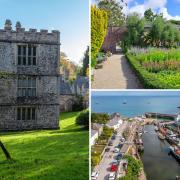Location

Bodmin Moor is the largest section of land in the Cornwall Area of Outstanding Natural Beauty (AONB) and includes both open and enclosed moorland. The Moor is bisected northeast to southwest by the main A30 highway.
The boundary of Bodmin Moor extends up to Davidstow Moor in the north, Upton Cross in the east, St Neot in the south and Tresarrett in the west. The moorland is dominated by the high hills and granite outcrops of Rough Tor and Brown Willy and contain several sizeable lakes. In contrast the southern edge of the moor contains several peaceful wooded valleys with meandering streams.
In total Bodmin Moor extends to 21,000 hectares (207 square kilometres) and is larger in its own right than many of the 45 other AONBs throughout the UK and covers more than a fifth of the whole of the Cornwall AONB designated area.
Getting out and about

Bodmin Moor is a rambler’s delight with plenty of walks criss-crossing the moor which provide a first-hand experience of the ancient landscape - make sure you keep to the recommended walking routes to avoid getting stranded in boggy ground.
iwalkcornwall.co.uk features a selection of walks on Bodmin Moor to suit all levels of ability from easy to moderate to strenuous, always make sure you choose your route carefully. For those who want to take a short walking break, The Copper Trail is a 60-mile walk that circumnavigates Bodmin Moor (there is a book that accompanies the walk which can be purchased from the Bodmin Visitor Centre ().
The Bodmin Visitor Centre also provides all the information you will need to make the best of your time visiting this AONB location and provide information places to stay during your visit ().
The centre is open all year round and the staff can help you to find your way about with local bus and train information.

This is the last of the monthly articles covering the twelve designated areas of outstanding natural beauty in Cornwall, we hoped you have enjoyed the read, if you would like to find out more about the Cornwall AONB please visit our website at cornwallaonb.org.uk where you will find further information about what we do. From time to time we also require volunteers in parts of the 12 designated Cornwall AONB areas and if you are interested in finding out more you can give them a call on 01872 322350 or drop them an email at info@cornwall-aonb.gov.uk
You can read all of the AONB articles online at
Bodmin Moor is a distinctive upland, created from an underlying granite mass which forms the backbone of the county of Cornwall. The highest point on Bodmin Moor is in the north west at Brown Willy, a peak of some 420 metres above sea level. Across the valley, the slightly lower Rough Tor, another granite outcrop is also the site of the remains of a 12th century medieval chapel. Both peaks together represent the highest points of land in Cornwall. The uplands are extensively covered with open moorland consisting mainly of coarse grassland, wetland and wet heathland, which includes scrub, bracken and gorse.
Much of the northern section of the moor is designated as a Site of Special Scientific Interest (SSSi). The peaty soil is generally poor with a high acid content which in turn has a significant impact on vegetation, providing a suitable environment for acid grassland, heather, gorse and bracken which tends to be grazed by small flocks of sheep, together with small herds of cattle and moorland ponies. Due to its exposed nature, Bodmin Moor is frequently subjected to high winds and rain blown in from the Atlantic and this in turn influences the type of vegetation found on the moor. Many streams and small rivers traverse the moor having penetrated weaknesses in the granite and eventually cascading into shallow falls at the edge of the granite shelf. Golitha Falls is a prime example of this type of feature where the river Fowey - which rises on Bodmin Moor - tumbles down a series of small waterfalls bounded by large mounds of lichen-covered granite and runs through an ancient wooded valley of sessile oak and ash –a complete contrast the barren moor upstream. The area surrounding Golitha Falls is rich in flora and fauna and is one of the three National Nature Reserves in Cornwall.

Bodmin Moor is hugely important historically; the open moorland reveals historic relics such as long cairns and hilltop enclosures from the Neolithic period, in addition, evidence of Bronze Age activity can be found in the ritual and domestic landscape of hut circles, barrows, cairns, and stone circles, the most notable being the famous near Minions. This unique Bronze Age monument (circa 1500BC) consists of a set of three standing stone circles and local legend has it that a group of local men were playing the Cornish game hurling on the Sabbath and were turned to stone as punishment. The Cheesewring can be found a short walk away to the north of the Hurlers - its shape has been the subject of lots of debates but it is actually due to the result of many hundreds of years of weather erosion on the granite strata of the moor.
A significant number of surviving holy wells and stone crosses are poignant reminders of the enduring importance of religion in the history of Bodmin Moor’s communities and the prominent engine houses and mining structures - especially in the south east of the moor near Caradon Hill and at Minions which are an acknowledgement of Cornwall and Bodmin Moor’s once great mining industry.
A visit to Bodmin Moor would not be complete without calling at the central hamlet of Bolventor (its name is a derivative of bold venture’ from attempts to recover tin from the many moorland streams). One of its biggest draws is the notorious Jamaica Inn made famous by Daphne Du Maurier’s 1936 novel of the same name. The greystone hotel and pub dates back to 1750 when its remoteness made it an attractive venue for smugglers, rogues and vagabonds. Today it includes a hugely popular visitor’s centre.
Other significant landscape features on Bodmin Moor include the two reservoirs of Colliford and Siblyback Lake and the smaller Dozmary Pool close to Colliford Lake which is famed for its association with the legend of Excalibur and one of the places thought to be the location of the Lady of the Lake’. The overall sense of wilderness on Bodmin Moor still endures, despite thousands of years of human intervention. It remains one of the few places in Cornwall where you can enjoy complete peace and tranquillity.
WILDLIFE – what to look out for
On the land
Bodmin Moor is the most south westerly upland in England and its warm and wet climate together with the harsh farming conditions have created an ancient, unique and distinctive landscape character providing a range of valuable wildlife habitats including, heathland, wetland, unimproved grassland, broad-leaved woodland, scrub, rivers, disused mine works, semi-improved and improved pastures and distinctive Cornish hedges.
The moor is a birdwatchers paradise. One of the key species is the golden plover which over-winters on the semi-improved pastures in significant numbers. Hen harriers, lapwings, redstarts, stonechats and whinchats as well as the resident ravens can all be spotted.
In the air
The internationally important marsh fritillary butterfly and nationally scarce bee hawk moth can also be found on Bodmin Moor as well as dragon and damsel flies. If you are lucky you may also catch a glimpse of an otter or two and in the early evening you are likely to spot both greater and lesser horseshoe bats which roost and feed in the woodlands, disused mines and old buildings.


























